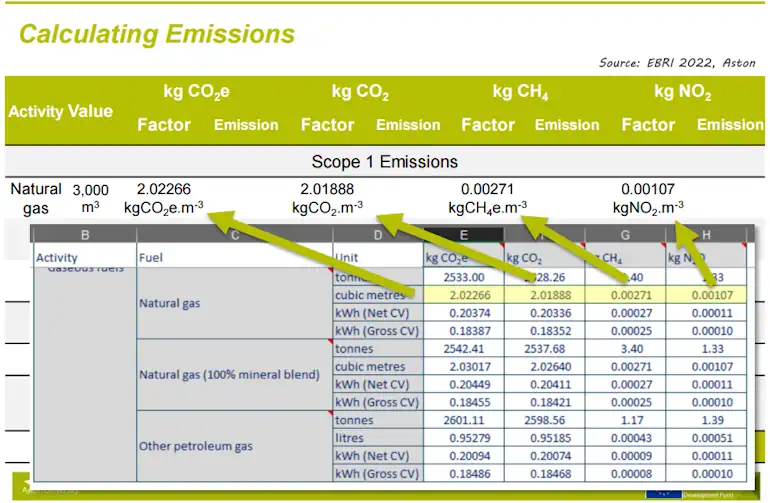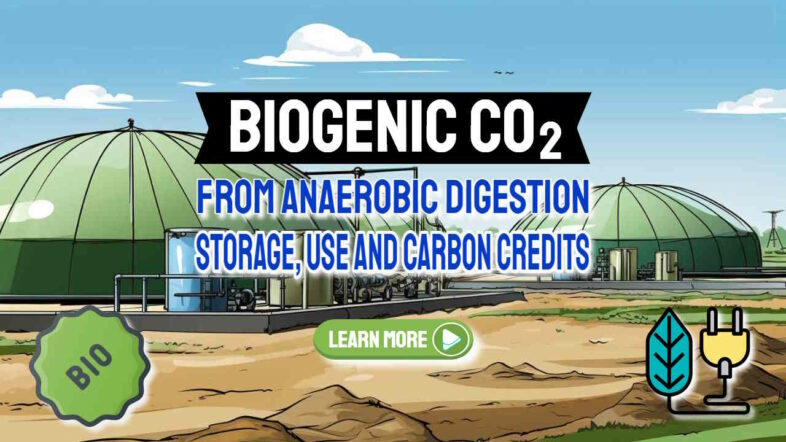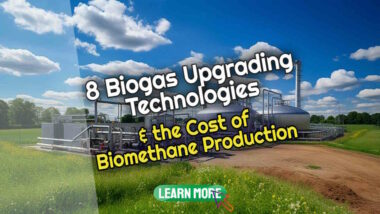Are you curious about how waste can be converted into a viable resource and help combat climate change? It's all thanks to Biogenic CO2 from Anaerobic Digestion – a process that produces valuable gases such as methane and carbon dioxide.
This blog will shed light on how this biogenic CO2 can be stored, used, and even have significant implications in earning carbon credits. Dive in to discover why anaerobic digestion could play a crucial role in our sustainable future.
Biogenic CO2 from Anaerobic Digestion Key Takeaways
- Biogenic CO2 from anaerobic digestion can be stored, used, and even earn carbon credits.
- Different storage methods for biogenic CO2 include tanks or cylinders, underground injection, and carbon mineralization.
- Biogenic CO2 has various utilization avenues in manufacturing industries and the food production chain.
- Carbon credits incentivize reducing greenhouse gas emissions, including biogenic CO2 from anaerobic digestion.
- Biogenic CO2 has a lower climate impact compared to fossil CO2 emissions.
- There are market opportunities for revenue generation through the utilization of biogenic CO2.
- Upgrading biogas to biomethane by separating out CO2 offers renewable energy production and storage of biogenic CO2.
- Biomethane has similar properties as natural gas but with a lower carbon footprint.
Understanding Biogenic CO2 from Anaerobic Digestion
Anaerobic digestion is a process that involves the breakdown of organic matter in the absence of oxygen, resulting in the production of biogas and biogenic CO2.
Definition and process of anaerobic digestion
Anaerobic digestion is a special process. It happens when organic stuff break down. This does not need air or oxygen. Tiny bugs in a closed tank do this job. They make biogas and other things like biofertilizer and biogenic CO2 from the food they eat.
Biogas has two main constituent parts – methane (60%) and carbon dioxide (40%).

Generation of biogenic CO2 during anaerobic digestion
Biogenic CO2 comes from the process of anaerobic digestion (AD). This happens when plant and animal waste break down in a place with no air. Heat helps speed up this process. The main things that come out are methane, which is a gas we can burn for heat or power, and biogenic CO2.
After that, there is an important step. We need to separate the methane from the CO2.
This makes sure we catch all of the biogenic CO2 so none of it gets lost into the sky. Biogenic CO2 is not harmful like fossil fuel-based CO2 because it's part of nature's carbon cycle.
Storage and Use of Biogenic CO2
Different storage methods exist for biogenic CO2, including geological storage, biological storage in forests or soil, and utilization as a feedstock in various industries.
Different storage methods for biogenic CO2
People store biogenic CO2 in various ways. One common method is to put it in large tanks or cylinders. This happens after the gas gets collected from the anaerobic digestion process.
Another way is underground injection, known as geological storage. Here, we pump the CO2 into spaces below earth's surface that hold oil, natural gas and saline solutions. Some also use carbon mineralization for storing this CO2 form.
In this case, they mix it with certain rocks causing a reaction which turns the gas into a solid state like stone. Each method has its own merits and suits different needs based on factors like cost, safety and available space.
Utilization avenues for biogenic CO2
Biogenic CO2 from anaerobic digestion has various avenues for utilization. One important area is in manufacturing, where CO2 plays a strategic role. Biogenic CO2 can be used in the food and beverage production chain, helping to create carbon-neutral products.
Additionally, biogenic CO2 can be stored and distributed for various applications. The demand for biogenic CO2 is growing as more industries seek sustainable alternatives to fossil-based CO2 emissions.
Its utilization presents an opportunity not only for reducing environmental harm but also for revenue generation through its capture and use in different sectors of the economy.
Carbon Credits and Biogenic CO2
Carbon credits play a crucial role in incentivizing the reduction of greenhouse gas emissions, including biogenic CO2 generated from anaerobic digestion.
Overview of carbon credits and their importance in offsetting
Carbon credits are an important tool in the fight against climate change. They represent a way to reduce greenhouse gas emissions by investing in projects that help remove or prevent the release of carbon dioxide into the atmosphere.
These credits can be bought and sold, allowing companies to offset their own emissions by supporting initiatives that reduce emissions elsewhere.
Carbon credits play a crucial role in encouraging sustainable practices and incentivizing businesses to take responsibility for their carbon footprint.
By purchasing carbon credits, companies support projects like renewable energy generation, reforestation, and methane capture from landfill sites, which have a positive impact on the environment.
Calculation and verification of biogenic CO2 emissions
Biogenic CO2 emissions from anaerobic digestion can be calculated and verified using specific protocols. These calculations take into account the carbon content of the feedstock used in the process, as well as any additional CO2 that may be produced during storage or utilization.
The verification process involves independent third parties reviewing and confirming the accuracy of these calculations. This ensures transparency and credibility in reporting biogenic CO2 emissions.
By accurately calculating and verifying these emissions, it becomes easier for organizations to track their environmental impact and make informed decisions about reducing their carbon footprint.
Climate Impact of Biogenic CO2
Biogenic CO2 from anaerobic digestion has a lower climate impact compared to fossil CO2 emissions, making it an environmentally friendly alternative.
Assessment of the climate impact of biogenic CO2
The climate impact of biogenic CO2 is an important aspect to consider. Biogenic CO2 emissions are different from fossil CO2 emissions because they come from the combustion, decomposition, or processing of biological materials.
It is crucial to assess the climate impact of biogenic CO2 to understand its contribution to global warming. Comparing the effects of fossil and biogenic CO2 emissions can help us determine the potential benefits of using or storing biogenic CO2.
This assessment will provide valuable insights for environmental researchers, waste management professionals, government officials, sustainability advocates, energy companies, landfill operators, environmental engineers, and policymakers in making informed decisions about carbon reduction strategies.
Comparison of fossil CO2 and biogenic CO2 emissions
Fossil CO2 and biogenic CO2 emissions are different in terms of their sources and impact on the environment. Fossil CO2is produced from burning fossil fuels like coal, oil, and natural gas, while biogenic CO2 comes from the decomposition or processing of biological materials.
Fossil CO2 is a major contributor to climate change because it adds new carbon to the atmosphere that has been stored underground for millions of years. On the other hand, biogenic CO2 is part of the natural carbon cycle as plants absorb atmospheric CO2 through photosynthesis and release it back when they decompose.
Although both types of emissions contribute to atmospheric CO2 levels, reducing fossil fuel consumption is crucial for mitigating climate change.
Market Opportunities for Biogenic CO2
There are various potential markets for the utilization of biogenic CO2, providing opportunities for revenue generation and promoting sustainable practices.

Potential markets for biogenic CO2 utilization
Biogenic CO2 from anaerobic digestion can be used in various markets, creating valuable opportunities. One potential market is the food and beverage production industry, where biogenic CO2 can be used to carbonate drinks or provide a controlled atmosphere for packaging.
Another potential market is the manufacturing sector, where biogenic CO2 can be used in processes such as dry ice production or metal fabrication. Additionally, biogenic CO2 has applications in greenhouse horticulture, as it can enhance plant growth and yields.
These markets offer avenues for revenue generation while promoting sustainability and reducing reliance on fossil fuels.
Opportunities for revenue generation through biogenic CO2
Biogenic CO2 from anaerobic digestion presents significant opportunities for revenue generation. This carbon dioxide can be captured during the process and utilized or stored for various purposes.
Industries, especially in manufacturing and food production, have a strategic need for CO2 and are willing to pay for a secure supply. By providing biogenic CO2, anaerobic digestion facilities can tap into these markets and generate income.
Additionally, there is potential for carbon credits, as biogenic CO2 emissions are considered more environmentally friendly than fossil CO2 emissions. This opens up avenues for financial incentives through carbon credit trading schemes.
Overall, leveraging the value of biogenic CO2 can contribute to both sustainability goals and economic prosperity.
Key facts:
– Biogenic CO2 from anaerobic digestion can be used in manufacturing industries.
Biomethane and Biogenic CO2
Upgrading biogas to biomethane and separating CO2 offers a sustainable solution for the production of renewable energy and the storage of biogenic CO2.
Upgrading biogas to biomethane and separating CO2
Biogas, which is produced through the anaerobic digestion process, contains both methane and carbon dioxide (CO2). To make biogas more useful and environmentally friendly, it can be upgraded to biomethane by removing CO2.
This process involves separating the different gases to increase the methane content and reduce the CO2 emissions. Upgrading biogas to biomethane has several benefits, including reducing greenhouse gas emissions and providing a renewable energy source.
Waste management professionals, environmental engineers, and policymakers are particularly interested in this process as it contributes to sustainable waste management practices and helps in achieving climate goals.
Properties and benefits of biomethane compared to natural gas
Biomethane, produced through the anaerobic digestion process, has several properties and benefits compared to natural gas. One key property is that biomethane has a much lower carbon footprint than natural gas.
This means that when biomethane is burned for fuel, it releases significantly fewer greenhouse gas emissions into the atmosphere. Biomethane also has similar energy content as natural gas, making it a viable alternative for various applications such as heating and transportation.
Additionally, biomethane can be easily injected into existing natural gas pipelines without significant modifications, allowing for seamless integration into existing infrastructure.
Carbon Removal and Storage Technologies
The anaerobic digestion process plays a crucial role in biomass carbon removal and storage, utilizing plants or algae to efficiently remove and store CO2, but it is not alone in this. The following is a list of some of the methods used.
Carbon removal and storage technologies will be essential tools in the fight against climate change. They are designed to capture and store or utilize carbon dioxide emissions, either from the atmosphere or directly from emission sources.
Here are some of the key carbon removal and storage technologies:
1. Carbon Capture and Storage (CCS)
– Pre-combustion capture: Carbon has until now rarely if ever been removed from fossil fuels before they are burned but this technology is being developed in the future by UK natural gas energy supplier Cadent.
They are about to commission the first hydrogen refineries which will convert natural gas to hydrogen. The hydrogen will be sent to homes and businesses through the gas grid instead of natural gas, while the captured carbon will be sent to carbon capture (sequestration) under the sea in the very natural gas fields previously emptied of their natural gas!
– Post-combustion capture: CO2 is removed after the fossil fuels are burned, typically at power plants. Demonstration projects have been more prevalent for post-combustion than for other capture systems since it may be retrofitted to existing power facilities.
The low partial pressure of CO2 in the flue gas is a significant challenge to the implementation of post-combustion capture technologies in coal-fired power plants. Since the flue gas is at ambient pressure and the CO2 content is very low (13-15%], there is no motive force to separate the gas. The result is a high energy demand technology.

Source: Carbon Capture and Storage Program (CCSP) Final report 1.1.2011–31.10.2016 – Scientific Figure on ResearchGate. Available from: www.researchgate.net [accessed 17 Aug, 2023]
– Oxyfuel combustion: Oxygen, instead of air, is used for combustion, producing a stream of COv that can be more easily captured. Capturing all of the CO2 and not releasing any pollutants into the air (no NOx) are two major benefits of this method. The requirement for a turbine in high-efficiency gas power plants is one major drawback, as is the high energy cost of air separation.
– Industrial separation: In industries like natural gas processing or certain chemical processes where CO2 is separated for commercial uses.
2. Carbon Capture and Utilization (CCU)
– Enhanced oil recovery (EOR): CO2 is pumped into depleted oil fields to push out more oil.
– Mineralization: CO2 is turned into solid minerals, like calcium carbonate.
– Bio-based materials: COv2 is used in the production of materials like plastics or concrete.
3. Direct Air Capture (DAC)
Uses chemicals to remove CO2 directly from the atmosphere.
4. Bioenergy with Carbon Capture and Storage (BECCS)
Plants or algae are grown to absorb CO2, then used as fuel with CCS technology, capturing the CO2 released during combustion.
5. Ocean Fertilization
Adding nutrients to the ocean to stimulate the growth of phytoplankton, which absorbs CO2.
6. Enhanced Weathering
Accelerates the natural process where minerals react with CO2 and turn it into stone.
7. Afforestation and Reforestation
Planting trees to absorb CO2 from the atmosphere.
8. Soil Carbon Sequestration
Techniques, like agroforestry or cover cropping, increase the carbon content in soils.
9. Blue Carbon
Conservation and restoration of coastal ecosystems, such as mangroves, seagrass meadows, and salt marshes, which sequester large amounts of carbon.
10. Carbon Mineralization
Reacting CO2 with rocks, such as basalt or peridotite, turning it into a stable mineral form.
11. Underground Storage
After capturing CO2, it can be pumped and stored deep underground in geological formations.
12. Biochar
Organic material is pyrolyzed to produce a charcoal-like substance, which is then buried, sequestering the carbon.
While these technologies offer promising solutions to address carbon emissions, they are part of a broader portfolio of measures, including reducing emissions at source and transitioning to renewable energy sources.
Now, having covered the breadth of this topic, let us return to biogenic carbon and the anaerobic digestion process again:
Overview of biomass carbon removal and storage using the anaerobic digestion process.
Notwithstanding the many technologies listed above, most are purely research topics at this time, other than biogenic carbon removal using the AD process. The anaerobic digestion process plays an important role in biomass carbon removal and storage. It involves the decomposition of organic matter to produce biogas, which consists of methane and carbon dioxide (CO2).
Through this process, CO2 can be captured and stored instead of being released into the atmosphere. This is crucial for reducing greenhouse gas emissions and mitigating climate change.
Biomass with CO2 capture and storage (Bio-CCS) is a method that captures and stores carbon from biomass, further contributing to carbon removal.
The use of anaerobic digestion technology stands out because it not only generates renewable energy but also provides a sustainable solution for managing organic waste while helping to combat climate change.
The role of plants or algae in removing and storing CO2
Plants and algae play a crucial role in removing and storing CO2 from the atmosphere through a process called photosynthesis. During photosynthesis, these organisms absorb CO2 from the air and convert it into energy, while releasing oxygen as a byproduct.
This helps to reduce the amount of CO2 in the atmosphere, acting as a natural carbon sink. Additionally, plants also store carbon in their biomass, including their roots and leaves, which can further contribute to carbon sequestration.
By harnessing the power of plants and algae, we can effectively mitigate climate change by reducing greenhouse gas emissions and promoting a more sustainable environment.
Accounting Framework for Biogenic CO2 Emissions
Measurement and reporting protocols are essential for accurately accounting for biogenic CO2 emissions, ensuring transparency and credibility in carbon footprint assessments.

Definition and measurement of biogenic CO2 emissions
Biogenic CO2 emissions are the carbon dioxide emissions that come from natural sources like plants, animals, and organic materials. These emissions occur during processes like combustion, decomposition, or processing of biologically based materials.
It's important to accurately measure these emissions to understand their impact on the environment. This involves quantifying the amount of biogenic CO2 emitted and developing protocols for reporting and accounting for these emissions.
By understanding and measuring biogenic CO2 emissions, we can make informed decisions about how to manage and mitigate their effects on climate change.
Reporting and accounting protocols for biogenic CO2 emissions
Biogenic CO2 emissions from anaerobic digestion need to be accurately measured and reported.
This is vital for environmental researchers, waste management professionals, government officials, sustainability advocates, energy companies, landfill operators, environmental engineers, and policymakers.
The reporting and accounting protocols ensure that the biogenic CO2 emissions are properly recorded and accounted for. These protocols help in monitoring the amount of biogenic CO2 generated during the anaerobic digestion process.
By following these protocols, stakeholders can have a clear understanding of the impact of their biogenic CO2 on climate change and devise appropriate strategies to mitigate its effects.

Biogenic CO2 from Anaerobic Digestion – A Conclusion
In conclusion, biogenic CO2 from anaerobic digestion has great potential for storage and use. It is an important gas in manufacturing and can help reduce our reliance on environmentally harmful fossil CO2.
By capturing and utilizing biogenic CO2, we can contribute to carbon neutrality and create market opportunities for revenue generation. With further development and investment, this technology could play a significant role in addressing climate change and achieving sustainability goals.
FAQs
1. What is biogenic CO2 from anaerobic digestion?
Biogenic CO2 from anaerobic digestion refers to carbon dioxide produced during the decomposition of organic waste in the absence of oxygen, such as in a digester.
2. How is biogenic CO2 stored and used?
Biogenic CO2 can be captured and stored for various purposes, including greenhouse gas mitigation or use in industrial processes like carbonating beverages or enhancing plant growth in greenhouses.
3. What are carbon credits?
Carbon credits are financial incentives given to organizations or industries that reduce their greenhouse gas emissions by using clean technologies or adopting more sustainable practices. These credits can be traded on carbon markets.
4. Can I earn carbon credits by utilizing biogenic CO2 from anaerobic digestion?
Yes, depending on local regulations and certification standards, you may earn carbon credits by capturing and utilizing biogenic CO2 from anaerobic digestion processes, helping offset your organization's overall emissions footprint.



![New [RE]fuel RTFC Pricing Service from Energy Census](https://anaerobic-digestion.com/wp-content/uploads/2018/01/New-RTFC-Pricing-Service-1920wCover-380x214.jpg)


Well, here we go again with the age-old narrative glorifying anything termed ‘biogenic’ and demonizing fossil fuels. This document seems to leap at the assumption that biogenic CO2 is somehow ‘friendlier’ to the environment. Let’s not be too hasty to herald this as a climate savior, shall we?
I find it curious that they conveniently omit discussing the potential negative impacts of mass-scale utilization of biogenic resources. Large-scale anaerobic digestion could lead to significant land use changes, not to mention the possibly detrimental effects on ecosystems and biodiversity. And let’s not even get started on the considerable energy consumption and infrastructure required for processing biological materials.
Furthermore, the theory that fossil CO2 somehow has a heavier impact on climate change is quite stretched, in my opinion. The carbon cycle is a naturally occurring process, and the addition of fossil CO2 back into the atmosphere is simply reintroducing what was once a part of the cycle millions of years ago.
So, before we jump on this ‘biogenic bandwagon’, perhaps we should consider that fossil fuels have been a reliable energy source for a reason and that their role in the current climate scenario might be blown out of proportion.